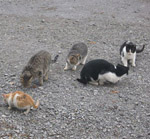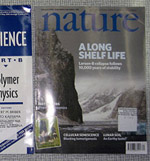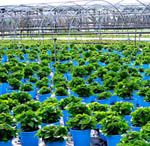Recovery of albatross may depend on removing paint
 Sand island Midway Atoll. Laysan albatross (Phoebastria immutabilis) with chick. Image credit, James Lloyd.
Sand island Midway Atoll. Laysan albatross (Phoebastria immutabilis) with chick. Image credit, James Lloyd.
Scientists estimate that lead paint chips from deteriorating buildings on the Midway Atoll are killing thousands of Laysan albatross juveniles every year. The poor chicks eat the paint chips, which cause toxic effects such as droopwing.
The research team led by Myra Finkelstein developed a demographic model to calculate the benefit that removing the lead paint would have for conserving the species. Their findings published in the journal Animal Conservation run counter to conventional thinking about population demographics and species conservation.
Laysan albatrosses, while numbering around 2 million individual worldwide have been in decline and are considered threatened largely because of the lethal impacts from long line fishing - adults attracted to the trail of bait get snagged by hooks and drown. The species has a long life span and very low fecundity (the albatrosses lay one egg per clutch and one clutch per year) which makes adult losses very problematic.
For species with these life history characteristics, standard demographic analysis shows that reducing adult mortality has a much greater benefit for the population than focusing on juveniles. On the surface, this would indicate that we should focus on long line fishing and not spend limited resources on removing the lead paint.
However, the study's analysis shows that removing the paint can make an important contribution to the rebound of the Laysan albatross by increasing the number of birds anywhere from 100,000 to 360,000 over the next 50 years.
Granted, this is only half the increase that would occur from reducing the annual adult mortality rate from long line fishing by 1% (e.g. from 5% to 4%). However, removing lead paint is a relatively simple action logistically - the US Fish and Wildlife Service has estimated that it would cost $5 million. Reducing long line bycatch, on the other hand, is a multinational, long-term endeavor that entails modifying the practices of a reluctant fishing industry
The researchers estimate that eliminating lead paint would equate to the same effect as reducing the fishing bycatch mortality by 1% for 21 years. So, in a sense it would buy us time to deal with the fishing bycatch problem. The authors calculate that removing the lead paint and reducing the bycatch mortality by 1% would together stabilize the population.
This research has important implications for species conservation beyond just the albatross. It shows that demographic patterns can help inform conservation planning, but analysis also needs to take into account other factors such as the cost, complexity, and time requirement of different alternatives. Otherwise, we may miss out on potential solutions to the problems we face. The study authors write,
"Even though these generalities about sensitivity patterns are robust, the implications of these patterns for conservation management planning have in some cases been elevated to the level of dogma, potentially hindering effective prioritization and conservation planning. In particular, the observation that population growth rates are influenced more heavily by the same proportional change in survival of adults than of young age classes has sometimes been misinterpreted to mean that only adult survival rates have meaningful influences on growth rates and hence should be the sole targets of conservation action."
The authors clairify that they are not saying that focusing on juveniles is more important than focusing on adults in long-lived, low fecundity species such as the Laysan albatross. Rather, focusing on juveniles can be worthwhile - especially when the solution is as simple as removing paint.
-Reviewed by Rob Goldstein
Finkelstein, M., Doak, D., Nakagawa, M., Sievert, P., & Klavitter, J. (2009). Assessment of demographic risk factors and management priorities: impacts on juveniles substantially affect population viability of a long-lived seabird Animal Conservation DOI: 10.1111/j.1469-1795.2009.00311.x




 Birds
Birds
Reader Comments